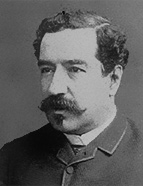

Nothing that prevented G. Pereira from becoming deeply involved in Évora's cultural development, following in the footsteps of A. Filipe Simões, Joaquim H. da Cunha Rivara, and Carl Justi. In 1886-1987, he was appointed councillor for Education at Évora's Municipal Council. In this role, he advocated for the creation of libraries and school museums, promoted evening education primarily for the working, industrial, and commercial classes, and contributed to the creation of a technical educational program specifically designed for local women. He also sought to bring to Évora the tradition of literary gatherings he had enjoyed in Lisbon, despite the greater conservatism of the Alentejo city, which already had organisations such as the 'Círculo Literário Eborense' (1837) and the 'Sociedade Harmonia Eborense' (1849). Like Eça de Queirós, G. Pereira attended the 'Sociedade Civilizadora União Eborense', then known as 'Bota Rasa' (1839, 1871), located in the city centre at Praça do Geraldo.
Invited by his former youth companion, António Enes, who played a key role in significant reforms at the Biblioteca Nacional (BN) [National Library], G. Pereira returned to Lisbon to take on the role of 'extraordinary employee' at the BN, to which he donated a glass lacrymatory for the antiques collection. The following year, he became a conservator and served as director until 1902, when, following the death of Tomás Lino de Assunção, he was appointed Inspector of the National Libraries and Archives. In this role, he conducted in-depth studies of the institution's collections, including illuminated codices. As director of the BN, G. Pereira was appointed by the Minister of Public Works, alongside José Leite de Vasconcelos, to assess the estate of the archaeologist Sebastião Estácio da Veiga, which would later become part of the Museu Etnológico Português [Portuguese Ethnological Museum] (1893). Meanwhile, in the lead-up to the establishment of the republic, he campaigned vigorously for a comprehensive reform of archival studies and practices in Portugal.
During this time, G. Pereira joined the Comissão dos Monumentos Nacionais (CMN) [National Monuments Commission] (Lisbon, 1881), where, in 1894, he co-organised three questionnaires aimed at cataloguing monuments for national classification and collected information on conservation and restoration projects. In 1897, he served on the committees responsible for the bulletin and the drafting of regulations, recognising the importance of the Arts & Crafts movement for the development of Portuguese industry. He rejected stylistic restoration in favour of scientific restoration and vehemently criticised the ignorance, apathy, and inertia of the national political authorities in this area.
This work is financed by national funds through FCT - Foundation for Science and Technology, I.P, in the scope of the projects UIDB/04311/2020 and UIDP/04311/2020.
